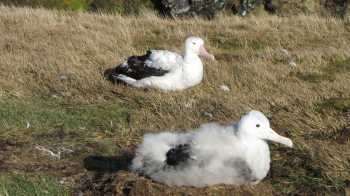Carly Summers has received a Master of Science from Clemson University (Clemson, South Carolina, USA) after studying lead and cadmium levels in some South African seabirds, including albatrosses and giant petrels at sub-Antarctic Marion Island.
The thesis abstract follows:
"Levels of lead (Pb) and cadmium (Cd) were investigated as potential stressors in adult African penguins (Spheniscus demersus ) in the Western Cape Province, South Africa and in nine species of breeding seabirds on Marion Island, South Africa. Seabirds are sentinels of environmental pollution and allow researchers to study contaminant dynamics in marine ecosystems. Many seabirds occupy high trophic positions, which gives [sic] them the potential to highlight threats to other apex predators from environmental pollutants. They also accumulate contaminants in higher concentrations because of their greater size and lifespan than may be detectable in lower trophic organisms. Blood samples were collected from African penguins between 2007 and 2011, and from nine species of seabirds on Marion Island in 2011. The whole blood method for graphite furnace atomic absorption spectroscopy was used to analyze samples. In penguins, the majority of blood Pb levels (97%) and blood Cd levels (80%) were within levels considered to be background exposure. Significant differences were observed among colonies, years, and seasons. The Pearson correlation coefficient between Pb and Cd for individual penguins was 0.3149 (p = 0.0005). Marion Island samples revealed individual blood Pb concentrations ranged from 0.80 (king penguin Aptenodytes patagonicus ) to 54.89 μg/dL (wandering albatross Diomedea exulans ), the majority of blood Pb levels (95%) were below background exposure. Species was a significant factor (p = 0.0005) for mean blood Pb levels, which ranged from 3.62 (dark-mantled sooty albatross Phoebetria fusca) to 14.68 μg/dL (wandering albatross). Fewer individual blood Cd levels (less than 60%) were within background exposure levels. Species was not significant (p = 0.7145). The Pearson correlation coefficient between Pb and Cd was r = 0.3389 (p = 0.0262), and varied by species. Overall, the results suggest Pb and Cd are not a primary cause for concern in these seabirds. This work contributes to a multi-disciplinary ecological risk assessment for the declining population of African penguins and a component of the Seabird Health Survey organized by the Southern African Foundation for the Conservation of Coastal Birds (SANCCOB)."
Other ACAP-listed species sampled at Marion Island were the Light-mantled Sooty Albatross P. palpebrata and Northern Macronectes halli and Southern M. giganteus Giant Petrels.

A Wandering Albatross and its downy chick at Marion Island
Photograph by John Cooper
Reference:
Summers, C.F. 2012. Lead and Cadmium in Seabirds of South Africa. Master of Science thesis. Clemson: Clemson University 94 pp.
With thanks to Nola Parsons for information.
John Cooper, ACAP Information Officer 29 October 2012

 English
English  Français
Français  Español
Español